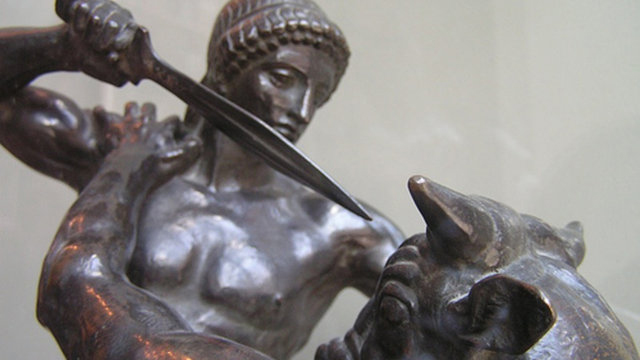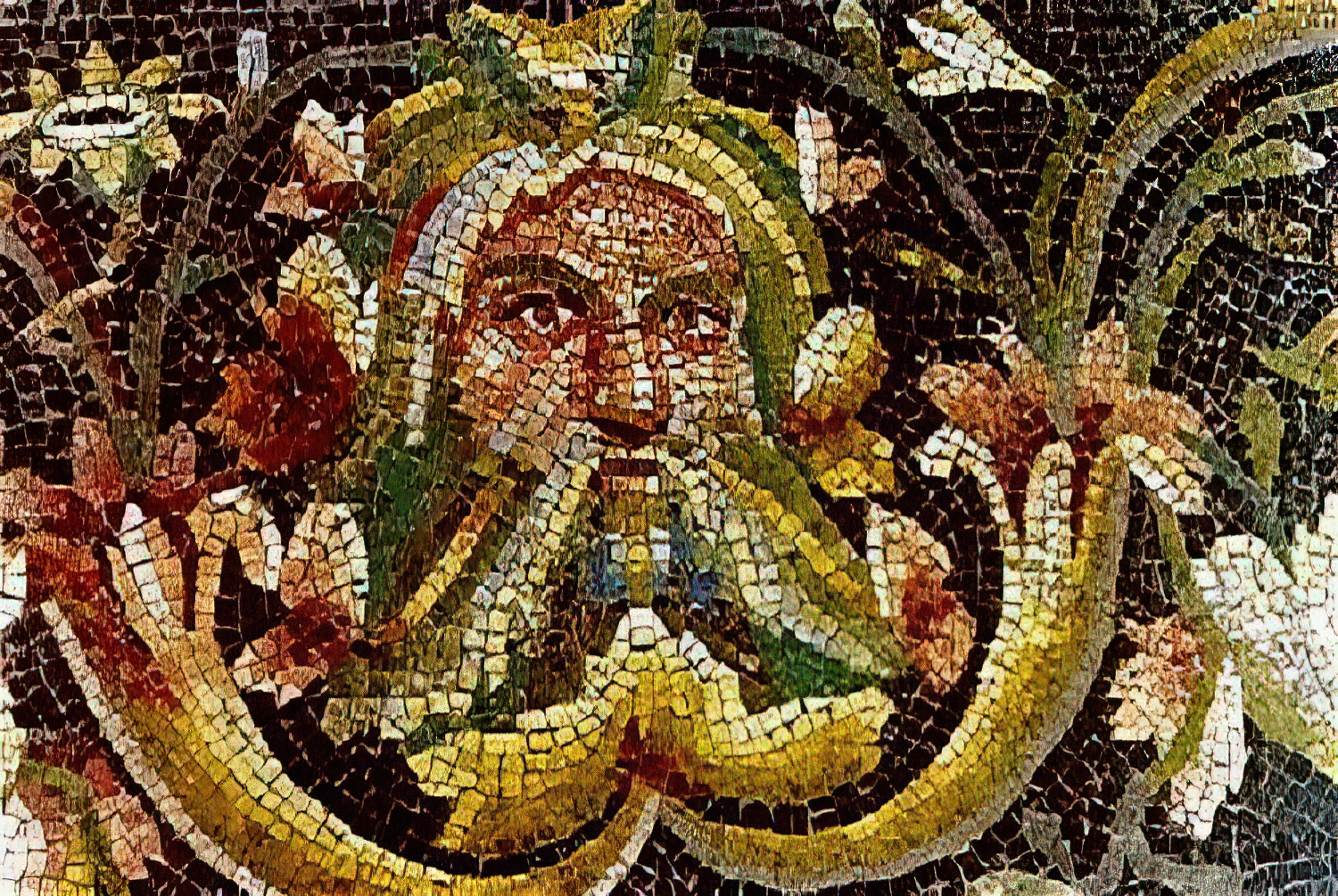I get a lot of questions from readers, and most of the time, the answers are
fairly short. When I feel the question or the reply would be valuable to others
as well, I make a post with a collection of them and post them in one go. Today
is one of those posts.
"Hi! Skiraphoria, Stenia, and Thesmophoria are the three festivals that only women are allowed to attend. What if i'm nonbinary? Should i not celebrate them? I look forward to read your answer :)"
There is no easy answer to this. The ancient Hellenes believed in the binary. Their entire society was based on that binary. It literally controlled every social interaction, every job, every ritual. It governed laws, politics, and even science and philosophy. It even dictated sexuality and the roles in homosexual contact. Ancient Hellas was divided in two.
Personally, I think the binary does not exist. As such, I tend to look at the function of rituals, and then give my opionion and advice. And I always, always, go by mind, not physique. Unless otherwise specified, I will always mean 'someone who identifies as' when saying 'male' or 'female'. So what of the non-binary?
The Stenia, Thesmophoria, and Skiraphoria are all tied to the Eleusinian Mystries and thus to the fertility of the land, agriculture, and harvest.
The Skiraphoria was one of the few days when the women of ancient Athens would gather in public to honor Demeter and bless the harvest. They refused to sleep with the men on this day and took part in a very odd tradition: casting piglets down into a chasm where they were left to rot until the Stenia.
The Stenia was dedicated solely to Demeter and Persephone and was held three days before the Thesmophoria. During the Stenia, women came together and begun the extensive purification rituals needed to partake in the Thesmophoria. How, exactly, the women purified themselves is unknown but it is known that the women engaged in Aiskhrologia, insulting each other and using foul language, in honor of Iambe, who cheered up a grieving Demeter by either lifting her skirts or making a dirty joke. At the Stenia, some women, called 'Bailers', hiked to the chasm where the piglets had been thrown into months ago. Then, in a gruesome display of devotion, the women hauled out the rotting corpses of the piglets and carried them to the Thesmophorion, a site probably on the hillside of the Pnyx.
During the Thesmophoria, there was a male and female encampment at the Thesmophorian and the division was clearly set; no men were allowed in the female encampment, and no women in the male encampment. Sex was not allowed. All free women, except for maidens, were allowed to participate. On the first day, called Anodos ('ascent') and Kathodos ('descent'), the women sacrificed the rotting piglets to Demeter and Persephone. The remains were mixed with seeds and would be plowed into the earth after the festival to assure a good harvest. The second day was called Nēsteia ('feast of lamentation'). On this day, the women did not eat. They recreated the time before Demeter taught humankind to cultivate the fields. The third day, Kalligeneia ('she who is of beautiful birth'), was a happy one. The women prayed to Demeter and Persephone for fertility for themselves, their loved ones and the earth. They celebrated the magic of new life, fertility and the kindness of the Gods.
The Skiraphoria and Stenia, in my opinion, are fairly 'stretchable' when it comes to who can attend. Traditionally it were women only, but the focus is fertility of the land, so I see no issue for those who are non-binary and identify with the festival in some way to attend.
So how about the Thesmophoria? The Thesmophoria ha an additional element: female fertilty, the act of human life growing in a uterus. So here the field is narrower. Do you identify with the biologically female side of reproduction? With motherhood? With pregnancy? Then join in. The same goes for cis-females, trans* women, those women who do not have children, and those women no longer physically capable of having them. It's a squishy line and it depends on the person.
My advice--for anyone--is to read up on the festival and look inside yourself to see if this is a ritual you can wholeheartedly celebrate.
***
"So what are your views on the creation of the world? I was curious about how you think about it."
The ancient Hellenic philosophers and mythographers were pretty much in
agreement that the Gods created the universe--or are the
universe itself. The most famous account of how everything came to be comes from
Hesiod. His '
Theogogy' is a
complete recounting of the story, starting with Khaos:
"Verily at the first Chaos came to be, but next
wide-bosomed Earth, the ever-sure foundations of all the deathless ones who
hold the peaks of snowy Olympus, and dim Tartarus in the depth of the
wide-pathed Earth, and Eros, fairest among the deathless gods, who unnerves the
limbs and overcomes the mind and wise counsels of all gods and all men within
them. From Chaos came forth Erebus and black Night; but of Night were born
Aether and Day, whom she conceived and bare from union in love with Erebus. And
Earth first bare starry Heaven, equal to herself, to cover her on every side,
and to be an ever-sure abiding-place for the blessed gods. And she brought forth
long Hills, graceful haunts of the goddess-Nymphs who dwell amongst the glens of
the hills. She bare also the fruitless deep with his raging swell, Pontus,
without sweet union of love. But afterwards she lay with Heaven and bare
deep-swirling Oceanus, Coeus and Crius and Hyperion and Iapetus, Theia and Rhea,
Themis and Mnemosyne and gold-crowned Phoebe and lovely Tethys. After them was
born Cronos the wily, youngest and most terrible of her children, and he hated
his lusty sire." [ll. 116-138]
He goes on to list a great many deities,
cutting out a rough shape of the cosmos while doing so. There are many
variations of this family tree, and in the ancient writings, there are also
creation stories that range beyond this basic framework. Many of them match very
well with science, though.
I believe in the theory of the Big Bang, where
the universe was in an extremely hot and dense state and began expanding
rapidly. After the initial expansion, the universe cooled sufficiently to allow
energy to be converted into various subatomic particles, including protons,
neutrons, and electrons. Giant clouds of these primordial elements later
coalesced through gravity to form stars and galaxies, and the heavier elements
were synthesized either within stars or during supernovae (courtesy of
Wikipedia, because of ease). I
see no issue in overlaying this theory with Hesiod's cosmology, however. The Big
Bang theory does sound like first there was Khaos, and from that, matter came
into being to eventually form the Earth as it is now. So as far as the creation
of the universe and the Gods goes, I will go with Hesiod and his explanation,
although a variation of his work is also fine by me.
***
"Hi Elani! I've been binding my hair for 15 months (and counting!) and while it feels right to me for many reasons, I'm curious to know more about it. Specifically, miasma. I read your post on your blog about binding hair, and you mentioned that unbound female hair is miasmic. Why is that? Also, why only female hair? Is it to do with length (and if so, if a man has long hair, is it miasmic too)? Or because of the association with funerary rites? Any information would be appreciated :) Thank you!"
Hair has long had an important role in society and religion. During the classical period female citizens wore their hair long except when they were in mourning during which they cut their hair short. Before the fifth century BC women's hair was allowed to fall over the shoulders and back, but it was often fastened by a headband or diadem, and the front section of the hair was restrained. After that, hair was often restrained. Female citizens, especially, wore their hair long, and after their marriage--usually at a very early age--they wore their hair up in elaborate styles. Typically, only their immediate family and servants saw Hellenic women with their hair undone.
Within a religious framework, hair was done up as well, unless otherwise specified. Many Dionysian rites, for example, encouraged women to literally 'let their hair down', and join in the revelry. For (married) women, it was extremely uncommon to wear their hair down outside of the oikos, and to do so must have helped them get out of their comfort zone. For other religious ceremonies, wearing the hair up was a way to apply katharmos, and prevent miasma from entering the ritual setting. This is a practice is still applied today, by yours truly included.
Plutarch (Ploútarkhos, Πλούταρχος) was a Greek historian, biographer, and essayist, who later in his life became a Roman citizen. As such, he was extraordinarily qualified to write two standard works: the 'Quaestiones Graecae' (Αἴτια Ἑλληνικά, or 'Greek Questions'), and the 'Quaestiones Romanae' (Αἴτια Ῥωμαϊκά, or 'Roman Questions'). These essays are part of the book series 'Moralia' (Ἠθικά, loosely translatable as 'Matters relating to customs and mores'), and can be found in book IV of the series. The Greek Questions contain fifty-nine questions, the Roman version hundred-thirteen, and all pertain to matters concerned with their respective culture. Many of the answers are names or customs, and because Plutarch often refers (back) to Hellenic customs, both are extremely valuable for research on ancient Hellenic life.
He writes in the 'Quaestiones Romanae': 'why do sons cover their heads when they escort their parents to the grave, while daughters go with uncovered heads and hair unbound?' and answers, partly, with the following:
"Is it because fathers should be honoured as gods by their male offspring, but mourned as dead by their daughters, that custom has assigned to each sex its proper part and has produced a fitting result from both? Or is it that the unusual is proper in mourning, and it is more usual for women to go forth in public with their heads covered band men with their heads uncovered? So in Greece, whenever any misfortune comes, the women cut off their hair and the men let it grow, for it is usual for men to have their hair cut and for women to let it grow." [14]
Women were supposed to wear their hair bound, and even veiled. In a Kthonic situation (like a death, or festival for a Kthonic deity), this would have been reversed, as everything in the rites was reversed--nighttime instead of daytime, unmixed wine instead of mixed wine, etc.--I am going to guess that because of this, unbound hair on women became associated with miasmic situations and thus they were not allowed to wear their hair down during Ouranic religious rites (and daily life). for me, that's enough to tie my hair.








